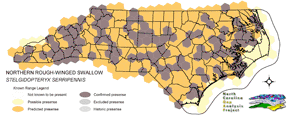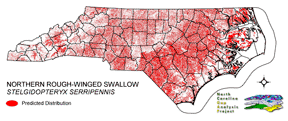
| Taxa: |
| Order: |
| Family: |
| Aves |
| Passeriformes |
| Hirundinidae |
| NatureServe Global Rank: |
| NatureServe State (NC) Rank: |
| G5 |
| S4B,SZN |
| Federal Status: |
| NC State Status: |
| --- |
| --- |


| Land Unit |
| US Fish & Wildlife Service |
| US Forest Service |
| US National Park Service |
| US Department of Defense |
| NC State Parks |
| NC University System |
| NC Wildlife Res. Com. |
| NC Forest Service |
| NC Div. of Coastal Mgmt. |
| Local Governments |
| Non-Governmental Org. |
| Other Public Lands |
| Private Lands |
| GAP Status 1-2 |
| All Protected Lands |
| Statewide |
| Hectares |
| 11,649.60 |
| 17,724.06 |
| 55,241.28 |
| 4,170.78 |
| 3,068.55 |
| 1,094.76 |
| 20,124.81 |
| 1,848.69 |
| 249.39 |
| 1,847.43 |
| 2,833.47 |
| 3,143.16 |
| 4,494,746.07 |
| 26,189.10 |
| 119,596.50 |
| 4,617,742.05 |
| Acres |
| 28,786.78 |
| 43,797.10 |
| 136,504.15 |
| 10,306.22 |
| 7,582.55 |
| 2,705.21 |
| 49,729.48 |
| 4,850.65 |
| 616.26 |
| 4,565.10 |
| 7,001.66 |
| 7,766.92 |
| 11,106,757.26 |
| 64,997.10 |
| 295,811.77 |
| 11,410,969.33 |
| % of Dist. on |
| Prot. Lands |
| 9.7 % |
| 14.8 % |
| 44.9 % |
| 3.5 % |
| 2.6 % |
| 0.9 % |
| 16.1 % |
| 1.5 % |
| 0.2 % |
| 2.3 % |
| 2.3 % |
| 2.1 % |
| < 0.1 % |
| 21.9 % |
| ----- |
| ----- |
| % of Dist. on |
| All Lands |
| 0.3 % |
| 0.4 % |
| 1.2 % |
| < 0.1 % |
| < 0.1 % |
| < 0.1 % |
| 0.4 % |
| < 0.1 % |
| < 0.1 % |
| < 0.1 % |
| < 0.1 % |
| < 0.1 % |
| 97.3 % |
| 0.6 % |
| ----- |
| ----- |
|
Fairly common throughout the state, with abundance depending upon nesting site availability (Potter et al. 1980). Found in any type of open habitat providing suitable cavities for nesting, but most often near streams, lakes, and river banks (Kaufman 1996). Also nest in rock quarries, railroad and highway cuts. The presence of nesting cavities may be a limiting factor in the species' distribution (Nicholson 1997). Usually nests in a vertical hole in a stream bank or similar sloping bank far from water. Will use a variety of cavities, including rodent holes (Ehrlich et al. 1988), drainpipes, culverts, holes in buildings (Kaufman 1996), kingfisher burrows, rock crevices, or tunnels in stream banks formed by rotten tree roots (Nicholson 1997). Usually nests solitarily but will occasionally nest in a loose colony or among a colony of Bank Swallows. Forages primarily by taking insects on the wing, but sometimes also on the ground (Ehrlich et al. 1988). NATURE SERVE GLOBAL HABITAT COMMENTS: Open and partly open situations, especially along watercourses with steep banks, and roadside cuts. Nests in burrows in cliffs, riverbanks, roadside cuts, culverts, drain pipes, holes in walls, under bridges; locally in caves and old buildings (RIDGWAYI group). In Costa Rica, often nests in burrow dug by motmot or kingfisher (Stiles and Skutch 1989). |
| Code | Name | Description | NC Natural Heritage Program Equivalent |
| 380 | Coastal Plain Fresh Water Emergent | Emergent vegetation in fresh water seepage bogs, ponds and riverbeds of the coastal plain. Includes alliances dominated by sedges, eelgrass, as well as cane found in unforested cane-brakes. | Small Depression Pond, Sandhill Seep, Floodplain Pool, Unforested Floodplain Canebrake, Riverscour Prairies, Vernal Pools |
| 173 | Coastal Plain Riverbank Shrubs | Shrub dominated riverbanks, commonly dominated by willows and/or alders. | Sand and Mud Bar |
| 78 | Pond-Cypress - Gum Swamps, Savannas and Lakeshores | Cypress dominated swamps and lakeshores. Can include bays dominated by pond cypress or shorelines of coastal plain lakes with a narrow band of cypress. | Non-riverine Swamp Forest, Natural Lakeshores (in part) |
| 42 | Xeric Longleaf Pine | Sandhills including a range of longleaf pine density from predominantly wiregrass, scrub oak dominated to true longleaf pine woodland. This does not include mesic or saturated flatwood types. | Xeric Sandhill Scrub, Pine/Scrub Oak Sandhill, Coastal Fringe Sandhill |
| 238 | Piedmont/Mountain Submerged Aquatic Vegetation | Seasonally to permanently flooded areas with aquatic vegetation. Waterlily, pondweed, hydrilla smartweed are a few of the species that can occur. | Piedmont/Mountain Semipermanent Impoundment (in part) |
| 239 | Piedmont/Mountain Emergent Vegetation | Emergent vegetation of all wetland hydrologies. Sites would commonly support species such as tussock sedge, rushs, and cattail alliances. | Rocky Bar and Shore (in part) |
| 267 | Riverbank Shrublands | Riverside shrubs with temporarily flooded hydrologies. Found in the both the Mountains and Piedmont. Containing dominants such as smooth alder and a Carolina or black willows. | Sand and Mud Bar |
| 269 | Floodplain Wet Shrublands | Saturated shrublands of the Piedmont, includes buttonbush, swamp-loosestrife, decodon and alders. | Piedmont/mountain Semipermanent Impoundment |
| 20 | Coniferous Regeneration | Regenerating pine stands. Predominantly loblolly pine, but slash and longleaf stands occur as well. | No equivalent |
| 36 | Successional Deciduous Forests | Regenerating deciduous trees with a shrub stature. Commonly dominated by sweetgum, tulip poplars and maples. | No equivalent |
| 180 | Agricultural Crop Fields | Farm fields used for row crops. | No equivalent |
| 205 | Agricultural Pasture/Hay and Natural Herbaceous | Farm fields used for pasture grass or hay production, as well as old fields dominated by native and exotic grasses. | No equivalent |
| 213 | Barren; quarries, strip mines, and gravel pits | Quarries, strip mines, or gravel pits. | No equivalent |
| 214 | Barren; bare rock and sand | Areas of bare rock, sand or clay. | No equivalent |
| 60 | Sand | Exposed sand, predominantly in the sandhills region where disturbance or the extreme site conditions prevent natural regeneration. | No equivalent |
| 202 | Residential Urban | Includes vegetation interspersed in residential areas. Includes lawns, mixed species woodlots, and horticultural shrubs. Vegetation accounts for between 20 - 70% of the cover. | No equivalent |
| 203 | Urban Low-Intensity Developed | Highly developed areas with vegetation accounting for < 20% of the cover. | No equivalent |
| 8 | Open water | Open water without aquatic vegetation. | No equivalent |
| 534 | Appalachian Wet Shrubland/ Herbaceous | Saturated shrubs and herbaceous vegetation. Often mapped as an inclusion in Appalachian Swamp Forest. | Southern Appalachian Bog, Southern Appalachian Fen |
|
Sheldon, F. H., and D. W. Winkler. 1993. Intergeneric phylogenetic relationships of swallows estimated by DNA-DNA hybridization. Auk 110:798-824.
Hagan, J.M., III, and D.W. Johnston, editors. 1992. Ecology and conservation of neotropical migrant landbirds. Smithsonian Institution Press, Washington, D.C. xiii + 609 pp. Johnson, N. K. 1994. Old-school taxonomy versus modern biosystematics:species-level decisions in STELGIDOPTERYX and EMPIDONAX. Auk 111:773-780. Phillips, A. R. 1994. The Known Birds of North and Middle America versus the current AOU list. Auk 111:770-773. Sauer, J.R., and S. Droege. 1992. Geographical patterns in population trends of neotropical migrants in North America. Pages 26-42 in J.M. Hagan III and D.W. Johnston, editors. Ecology and conservation of neotropical migrant landbirds. Smithsonian Institu Kaufman K. 1996. Lives of North American Birds. Boston, New York: Houghton Mifflin Company. Nicholson CP. 1997. Atlas of the breeding birds of Tennessee. Knoxville: University of Tennessee Press. Oberholser, H.C. 1974. The bird life of Texas. 2 vols. Univ. of Texas Press, Austin. Lunk, W.A. 1962. The rough-winged swallow STELGIDOPTERYX RUFICOLLIS (Veillot) [= S. SERRIPENNIS] - A study based on its breeding biology in Michigan. 241 pp. Godfrey, W.E. 1966. The birds of Canada. National Museums of Canada. Ottawa. 428 pp. Harrison, C. 1978. A field guide to the nests, eggs and nestlings of North American birds. Collins, Cleveland, Ohio. Potter, E. F., J. F. Parnell, and R. P. Teulings. 1980. Birds of the Carolinas. Univ. North Carolina Press, Chapel Hill. 408 pp. Terres, J.K. 1980. The Audubon Society encyclopedia of North American birds. Alfred A. Knopf, New York. American Ornithologists' Union (AOU), Committee on Classification and Nomenclature. 1983. Check-list of North American Birds. Sixth Edition. American Ornithologists' Union, Allen Press, Inc., Lawrence, Kansas. Phillips, A.R. 1986. The known birds of North and Middle America:distribution and variations, migrations, changes, hybrids, etc. Part I, Hirundinidae to Mimidae, Certhiidae. Published by the author, Denver, Colorado. lxi + 259 pp. Robbins, C.S., D. Bystrak, and P.H. Geissler. 1986. The Breeding Bird Survey:its first fifteen years. U.S. Fish and Wildlife Serv. Resource Publ. 157. iii + 196 pp. Ehrlich, P.R., D.S. Dobkin, and D. Wheye. 1988. The birder's handbook:a field guide to the natural history of North American birds. Simon and Shuster, Inc., New York. xxx + 785 pp. Stiles, F.G., and A.F. Skutch. 1989. A guide to the birds of Costa Rica. Comstock Publ. Associates, Cornell University Press, Ithaca, New York. 511 pp. Turner, A., and C. Rose. 1989. Swallows and martins an identification guide. Houghton Mifflin Co., Boston. |
For more information please contact them at:
NC-GAP Analysis Project
Dept. of Zoology, NCSU
Campus Box 7617
Raleigh, NC 27695-7617
(919) 513-2853
www.basic.ncsu.edu/ncgap